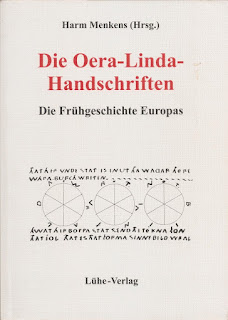
[this post was somewhat edited April, 2023]
*** for a list of online publications about Oera Linda, go here ***
Mine (read online or buy printed copy/PDF) is the first English translation straight from the original language, as the one by Sandbach (1876) was based on the first Dutch one by Ottema (1872). The Sandbach translation was the basis for most other (non-Dutch/German) ones.
The earlier translations (known to me) that were straight from the original language are:
Dutch:
Ottema - 1872, 1876
Overwijn - 1941, 1951
Jensma - 2006 (1)
De Heer - 2008 (2)
(1) This is the only translation that was based on the assumption that the text is a 19th Century forgery, meant as a joke.
(2) Translation is mostly based on Overwijn but uses unique Yule-font for transcription of the original text.
German:
Wirth - 1933 (some parts were left out)
Menkens - 2013
Norse and improvised English:
Lien - 2013 (web-only)
Chronological list of Oera Linda translations (known to me)
| year | author | language | title | publisher |
| 1872/ 1876 | J.G. Ottema | Dutch | Thet Oera Linda Bok | H. Kuipers, Leeuwarden (1, 2) |
| 1876 | W.R. Sandbach(1) | English | The Oera Linda Book | Trübner & co., London |
| 1933 | H. Wirth(2) | German | Die Ura Linda Chronik | Koehler & Amelang, Leipzig |
| 1941/ 1951 | J.F. Overwijn | Dutch | Het Oera Linda Boek | N.V. Enkhuizer Courant/ Chefferd/ web-PDF |
| 1963 | E. Sturm | German | Die Oera Linda Handschriften | typewriter copy |
| 1983 | F.H. Pierce | English | The Œra Linda Book | typewriter copy |
| 1992 | U. & J. Hamilton | Swedish | Oera-Linda : en Fornfrisisk Krönika | Cradle Publications |
| 1998 | A. Snyman | Afrikaans | Die Oera Linda boek | Vaandel-Uitgewers, Mosselbaai |
| 2004 | A. Soldani | Italian | Oera Linda il libro, pagine di storia dimenticate | web-only |
| 2006 | G. Jensma | Dutch | Het Oera Linda-boek | Verloren, Hilversum |
| 2007 | J. Fermaut(3) | French | Le livre des Oera Linda | selfpublished, Bierne |
| 2008 | S. de Heer(4) | Dutch | Ћet Oera Linda Bok | self-published, Amsterdam |
| 2012 | A. Pietrykowska | Polish | Ksiñega Oera Linda | Armoryka, Sandomierz |
| 2013 | H. Menkens | German | Die Oera-Linda-Handschriften | Lühe-Verlag, Süderbrarup |
| 2013 | H.O. Lien | Norse/ (English) | Oera Linda-boka/ (The Oera Linda Book) | web-only |
| 2017 | D. Campayo Bustos | Spanish | Oera Linda - un manuscrito del siglio XIII | web-only |
| 2018 | Adel Brost (pseudonym) | German | Oera Linda Buch | web-only |
| 2020 | Ανωνυμου | Greek | Το βιβλίο του Oera Linda - Μαρτυρες Της Αντλαντιδας | Υπατια Λυδια |
| 2021/ 2022 | Jan Ott | English | Codex Oera Linda (various editions) |
oeralinda.org |
(2) Wirth left out some parts.
(3) Translation of Ottema (1876?).
(4) Bewerking van Overwijn (1951).
Note: the English translation that was published as an appendix to "Survivors of the Great Tsunami" (2010/2011) and "Chronicles from pre-Celtic Europe" (renamed third edition, 2014), self-published by A.J. Raubenheimer were edited versions of the Sandbach translation.
Some of the translations in my collection:
 |
 |
 |
 |
 |
|
|
|
...
|











